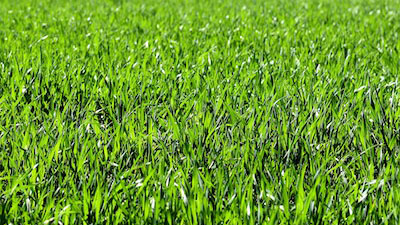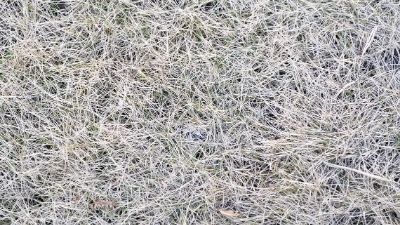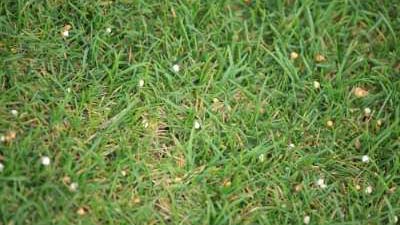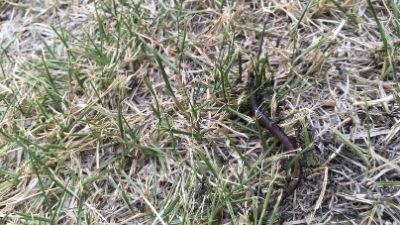Basic Turfgrass Care
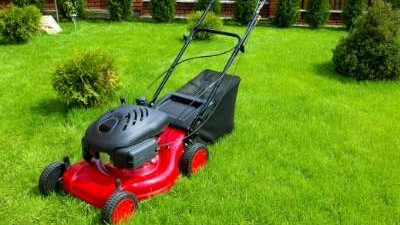
The basic practices of turfgrass care include mowing, fertilization, and irrigation. In Utah, our climate has a unique effect on the turfgrasses that we grow and proper basic care will help to keep your lawn healthy and attractive.
Mowing
Mowing is the most basic cultural practice for managing your lawn and is one of the easiest things you can do to improve the grass’s appearance. Proper mowing controls most weeds, increases the density and uniformity of the turf, and helps maintain healthy plants.
It’s easy to mow properly, but there are a few things to consider. Different turfgrass species require different mowing heights, however, the commonly used turfgrass species for lawns in Utah, including buffalograss, can all be mowed at a height of 2-4 inches. This may be higher than you currently mow your lawn, but there are good reasons for raising your mowing height.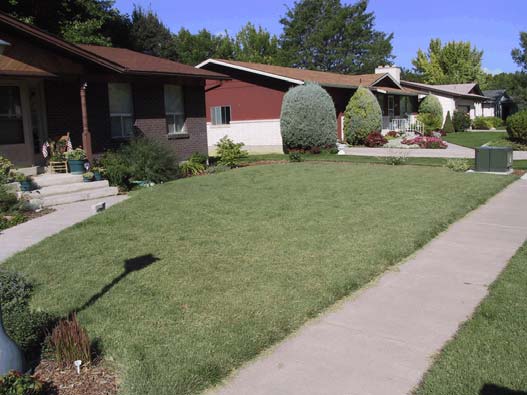
Taller grass means deeper roots. This is important in our cool-arid climate because it allows the grass to use water that is deeper in the soil. When conditions are hot and dry, deeper roots can mean the difference between an attractive, healthy lawn and a thin, weak one. Consider mowing grass in shaded areas higher than in sunny areas to allow more leaf area for collecting available sunlight.
How often should you mow? Just remember the “1/3 Rule.” Ideally, you should never mow more than 1/3rd of the total length of the grass blades off at a time. For example, if your lawn is a little more than 4 inches high, mow no lower than 3 inches. If your lawn is VERY long, its best to gradually lower the mowing height over several mowings, down to your desired mowing height. In practice we have all cut an overgrown lawn down all at once and it has recovered. The key is not to repeat that practice over and over. Turfgrasses are forgiving plants, but there is a limit.
Finally, return or mulch the clippings whenever possible. These clippings return nitrogen to the soil and help decrease evaporation. Why bag and/or landfill your clippings when they can save you money and be such a benefit to your lawn?
Fertilization
To answer the question of how much fertilizer to put onto your lawn, first consider your level of maintenance and use of the lawn. In general, the cool-season grasses typically grown in Utah require from 2-5 lbs of nitrogen per 1000 sq ft per year. Rates at the higher end (4-5 lbs) are for only the most intensively used and managed turfgrasses. The higher rates may also be appropriate for play areas where the grass needs to repair itself due to traffic.
A moderate level of maintenance (for a typical home lawn) requires only 2-3 lbs of nitrogen per 1000 sq ft per year. The timing of fertilizer application is dictated by the growth pattern of the grass and it’s best to fertilize when the plants can take up the nutrients most effectively.
Irrigation
In Utah, proper turfgrass irrigation is essential for the health of the plants and will also help to conserve our limited water supplies. There are several basic guidelines that will help.
- Irrigate in early morning when temperatures are cool and the wind is not blowing to prevent evaporation losses.
- Avoid irrigating between 10 AM and 6 PM to minimize evaporation.
- Check your irrigation system monthly for leaks and damaged or clogged sprinkler heads.
- Mow at 3 inches to improve heat and drought tolerance of the grasses.
- Aerate your lawn to improve water infiltration and reduce compaction and thatch.
- Accept a less-than-perfect lawn. During drought, grass will take on a golden color as it goes dormant but will recover as temperatures cool and water becomes available. Avoid excessive traffic on dormant turfgrass.
- When puddles form or water runs off during irrigation, water in short, repeated cycles. Allow one hour in between cycles for water to move into the soil.
- Adjust your irrigation controller seasonally to meet the actual water requirements of the grass. Your lawn requires different amounts of water depending on the season. For example, more irrigation will be required in the summer than in the spring or fall.
Ideally, you should apply between ½ and 1 inch of water each time you irrigate. Remember to shorten and increase the number of irrigation cycles if puddling or runoff occur.
| Irrigation | |
|---|---|
| Northern Region | April to October |
| Southern Region | March to November |
| Aeration/Cultivation | |
|---|---|
| Northern Region | March to May, September to October |
| Southern Region | January to May, September to October |
| Fertilization | |
|---|---|
| Northern Region | April, June, October |
| Southern Region | April, June, October |
| Mowing | |
|---|---|
| Northern Region | March to November |
| Southern Region | February to November |
| Seeding/Overseeding | |
|---|---|
| Northern Region | April to May (Good), September to October (Best) |
| Southern Region | February to April (Good), September to October (Best) |
Published March 2011
Utah State University Extension
Peer-reviewed fact sheet
Download PDF
Authors
Kelly Kopp, Associate Professor and Extension Water Conservation and Turfgrass Specialist; Paul Johnson, Associate Professor, Plants, Soils and Climate Department
Related Research



